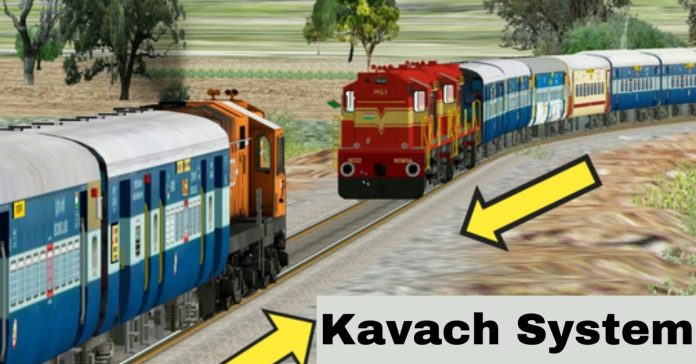What is Kavach?
Kavach is an automatic train protection system developed by Indian Railways to enhance train safety. It was created indigenously by the Research Designs & Standards Organisation (RDSO) in collaboration with three Indian vendors. The name “Kavach” means “armor” in Hindi, reflecting its protective role in railway operations.
Key Features
- Cab Signaling Train Control System: Kavach incorporates cab signaling with anti-collision features and serves as the National Automatic Train Protection (ATP) System.
Safety Standards: It adheres to Safety Integrity Level-4 (SIL-4) standards, providing high-level safety assurance. It serves as a watchful guardian over the current signaling system, warning the loco pilot when a “red signal” is coming and braking automatically if needed.
- Emergency Response: The system can relay SoS messages during emergencies.
- Centralized Monitoring: Kavach includes centralized live monitoring of train movements via the Network Monitor System.
- Centre of Excellence: The Indian Railways Institute of Signal Engineering & Telecommunications (IRISET) in Secunderabad, Telangana, hosts the ‘Centre of Excellence’ for Kavach.
Components
Kavach’s deployment involves three main components:
- Trackside RFID Technology: Radio Frequency Identification (RFID) tags are installed on the tracks. RFID uses radio waves to identify objects and read device information wirelessly.
- Locomotive Equipment: The driver’s cabin is equipped with RFID readers, a computer, and brake interface equipment.
- Radio Infrastructure: Towers and modems are installed at railway stations to support communication between the train and the control system.
Deployment Challenges
- Cost: The deployment cost is ₹50 lakh per kilometer, with current coverage of about 1,500 km out of the 68,000 km rail network, presenting a significant challenge for widespread implementation.
Development and Testing
- Origins: Development began in 2011 under the name Train Collision Avoidance System (TCAS), with initial proof of concept in 2012.
- Field Trials: Between 2015 and 2017, field trials were conducted to refine the system, leading to its final approval in 2019.
- High-Profile Demonstrations: In March 2022, a live demonstration successfully prevented a collision between two locomotives, showcasing Kavach’s effectiveness.
Description
Kavach’s system includes:
- Trackside RFID Tags: These are installed between the running rails to provide location and direction data.
- Onboard Equipment: Includes RFID readers, a computer, brake interface equipment, and communication links (UHF and GSM radios).
- Radio Infrastructure: Towers and modems are deployed at regular intervals along the tracks, often aligned with existing signaling equipment.
Functionality
- Automatic Safety Measures: Kavach automatically alerts drivers and applies brakes if a train passes a stop signal or if another train is detected on the same line.
- Continuous Monitoring: It continuously monitors train movements and is unaffected by visual obstructions or adverse weather conditions.
- Integration: Kavach integrates with signaling control stations, retrieving information on signal aspects, permitted speeds, and movement authority.
Deployment and Future Plans
- Current Implementation: In the South Central Railway zone, Kavach is being used on 65 locomotives, 1,445 km of track, and 134 stations. It is intended to be upgraded to accommodate trains traveling at up to 160 kmph.
- Future Expansion: The Union budget for FY 2022-23 allocated funds for rapid implementation along 2,000 km of track, with plans to extend it to 34,000 km of the Golden Quadrilateral rail route by 2027-2028.
Conclusion
Kavach represents a significant step forward in railway safety for Indian Railways. Its advanced technology, coupled with ongoing and planned expansions, aims to drastically reduce train accidents and enhance the overall safety and efficiency of rail travel in India.
Frequently Asked Questions (FAQ’s)
Ans: Kavach is an automatic train protection (ATP) system developed by Indian Railways. It is designed to enhance the safety of running trains by preventing collisions and ensuring trains do not overshoot signals.
Ans: Kavach was developed indigenously by the Research Designs & Standards Organisation (RDSO) in collaboration with three Indian vendors.
Ans: Kavach uses a combination of trackside RFID tags, onboard RFID readers, computers, brake interface equipment, and radio infrastructure to monitor and control train movements. It alerts drivers to dangerous situations and can automatically apply brakes if necessary.






































